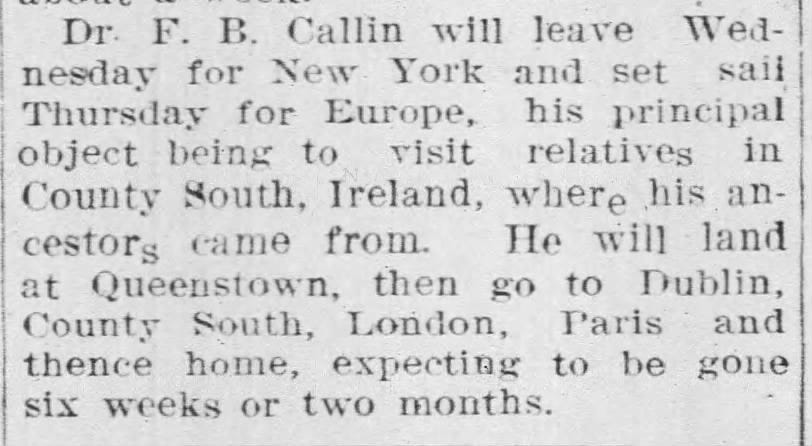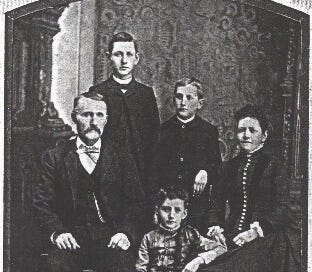
George William Callin (1846-1921) was one of us: a genealogist.
He was active during a time when Americans enjoyed a newfound sense of optimism and possibility about their place in the world and when average men, like those in his family, were documenting their own lives as if they were the Great Men of history.
He published his research in a book called “The Callin Family History” in 1911, paying for the printing of an unknown number of copies bound in red leather. My grandfather received one of those copies, which found its way to me. In 2015, I published a replica of it on Lulu.com so any interested researchers could inspect it for themselves:
Learning From His Efforts
I have written before about some of the flaws in this book. George did not cite any of his sources, and he framed several claims about the origins of the Callin family as received wisdom from “our fathers,” who may or may not have had first- or even secondhand knowledge of the “facts” they passed on.
My early research grew out of George’s book. I used the facts he documented to hunt for census records using free Ancestry and FamilySearch records, and eventually expanded to a full Ancestry subscription that allowed me to fill in a lot of gaps using Newspapers.com and Fold3.
I re-published George’s book in 2015 as part of my project to update his work and provide source citations to support (or refute) his claims. Seven years later, I published my own imperfect document: an 800-page behemoth capturing up to seven generations of descendants of the man George referred to as “James 1st,” a Revolutionary War soldier who may or may not have been born in Ireland.
Who Did George Meet?
As I built my Callin Family History, it became clear that George didn’t use many official records. More likely, he got his information by speaking to his older relatives and relying on their memories. The closest he comes to referring to records is this statement early on:
Making deductions from the earliest known marriage record, that of Thomas
Callin, grandson of James 1 st , the order of descent would be like this…
Some hints suggest George corresponded with relatives who lived outside of Ohio, but I think he gathered most of the information for his book from relatives who returned to Ohio for annual family reunions, the first of which he hosted in 1906 at his home on “the corner of Pearl and Buttonwood avenue, Bowling Green, Ohio.”1 That article, and those documenting later reunions held in Akron in 19102 and in Bowling Green (again) in 1914, list the attendees, which I can compare with the contents of George’s book to see if I can tell who he met, and who got left out of his book.
(I was going to try to talk about that in this post, but it is turning out to be a deep, time-consuming rabbit hole involving a spreadsheet and multiple lists of 50-75 attendees… some of whom I also missed!)
The upshot is that George was acquainted with many of his cousins and their children who lived in Ohio.
An Elusive Irish Source
You might recall that I wrote about Dr. Fred Callin a while back, in The Angry Doctor. Dr. Fred was another family historian, and he was listed among the attendees of the 1906 Callin Family reunion, where, according to The Daily Sentinel Tribune:
Away off in Ireland one of the members of the Callin family and written and sent an interesting letter which was read aloud.
I speculate that the writer of this letter might be the person Dr. Fred visited the following year:

I have been skeptical over the years of the family’s claims to Irish heritage, but these tantalizing clues suggest that they had something more solid than a vague legend of the Old Country. I just wish they had recorded their relationship.
Who George Did/Didn’t Know
While I can puzzle out who George met during his later years, I have to make some educated guesses about who he knew as a child. George knew his parents, William Callin and the former Elizabeth Berlin. He probably only received oral history from them. I know from the essay written by George’s daughter, Rosemary, in 1973, that Elizabeth was illiterate until her sons enlisted to fight in the Civil War. I assume that William was also illiterate, based on this description, which may have been written by his grandson, Byron H. Callin, in 18953:
“He was an industrious, hardy, persevering man, possessing great physical strength, but had only a limited knowledge of books. He had a mind of keen perception and sound judgment, and was well fitted for pioneer life.”
George did not know his grandfather, John Callin, who died of tuberculosis in 1835. He might not have met his grandmother, John’s widow, the former Elizabeth Simon. She lived with her daughter, Eliza (Callin) Ferguson, in Auburn, Indiana, in 1860, and may have moved to Auburn when the Ferguson family moved between 1840 and 1850. George was born in 1846, so depending on how long Elizabeth remained in Ohio, he may have known her at a time when he was old enough to have memories about her. George’s book is the only source I have found that tells us Elizabeth Simon’s maiden name.
George did include descendants of his aunt Eliza Ferguson in his book, so it is possible he met some of them at a reunion, or perhaps traveled to Auburn to visit them. He also included some limited information about his aunt Ann (Callin) Campbell and her surviving children.
His father’s oldest sister, Sarah (Callin) Scott (1801-1872), married and moved to Illinois with her husband before George was born, and no one in Ohio seems to have maintained contact with them. Finding them in Rockford, Winnebago County, Illinois, was one of my proudest accomplishments for the revised Callin Family History.
William had six cousins, some of whom are documented in George’s book. Only Thomas Callin remained in Milton Township, and he died three years before George was born. Thomas and his wife, Nancy (Burget) Callin, had ten children, but five of them survived childhood. Most died before George was born, and only the family of Thomas Jefferson (Jeff) Callin was well documented in George’s book. Jeff’s brother, Marquis, was believed to be dead by the time George compiled the book.
Three of Thomas’s siblings married Montgomerys, and we have been discussing them in our “Milton Township Diaspora” posts recently. But George did not seem to know about them at all. George only documented Thomas, Alec, and James; he did not mention Elizabeth, Sarah, or Hugh.
And that makes sense when you think about who would have still been around central Ohio after the Civil War. The Montgomery families (Elizabeth’s and Sarah’s children) were long gone by the time George began researching. And when we talk about the Iowa group (Alec, Hugh, James, and William’s sister, Margaret), they all moved in the decade before George’s birth and probably (mostly) died off.
To Be Continued…
I breezed past a ton of material in the last five paragraphs, and I do plan on giving more time to each of the families I mentioned. I learn more each time I revisit them, and it has been a while since I re-investigated the folks who moved to Iowa and then (mostly) died out. I have yet to find Alec’s descendants, and I know they ought to exist!
So, with all due gratitude to George for leaving his record in print, we will continue seeking to fill in the gaps.
Newspapers.com, The Daily Sentinel-Tribune, Bowling Green, Ohio, Thursday, August 16, 1906, "Callin Reunion" : accessed 26 May 2025.
Newspapers.com, The Akron Beacon Journal, Akron, Ohio, Thu, Aug 18, 1910, Page 2, Callins In Reunion : accessed 26 May 2025.
Commemorative Historical and Biographical Record of Wood County, Ohio , J.H. Beers, Chicago, 1897, pg 923-924.




Interesting to think about the sources he would have had access to for his family history and your deductions of who he would have known during his lifetime.
In that time period Genealogy was quite a fad, consequently many are badly written and poorly sourced. Their resources at the time included interviews with oldsters in the family and connecting through genealogy want ads in newspapers. So much of it is backed by the collective memories of the oldest memories of the family. The purpose of those books was not facts and truth, it was the creation of the families' origin story.